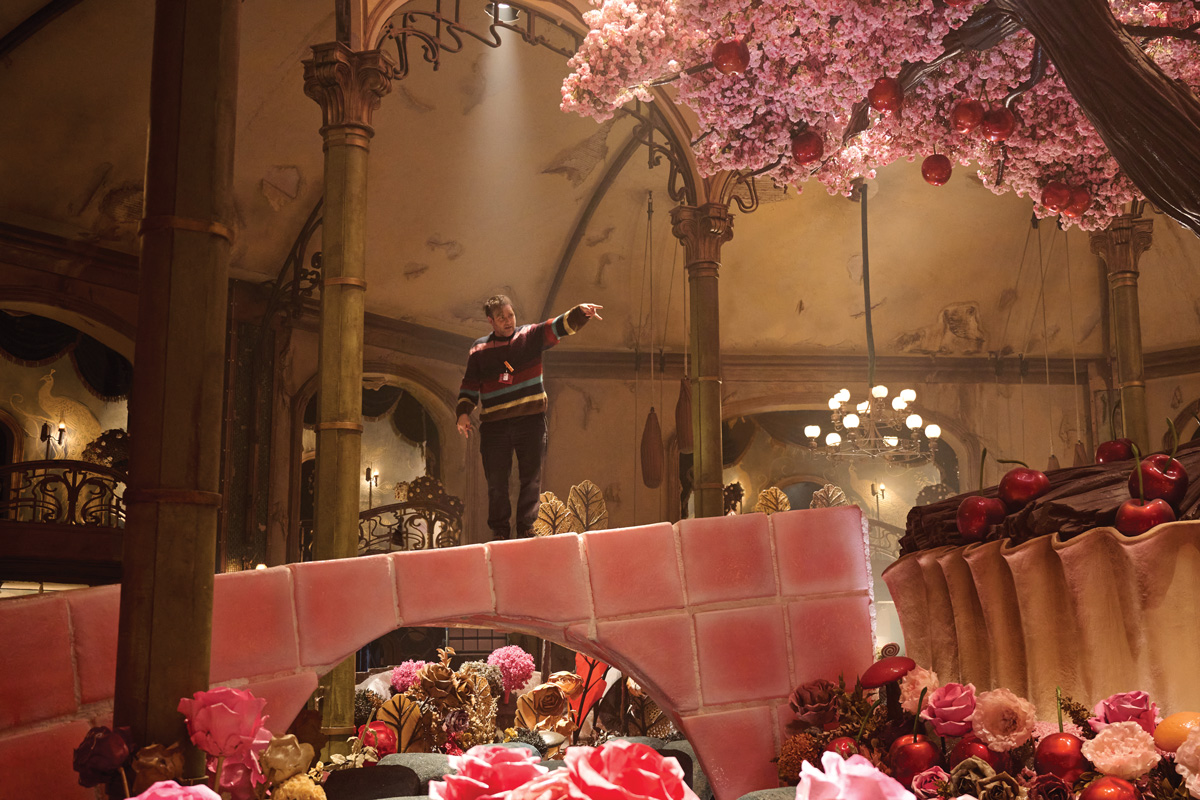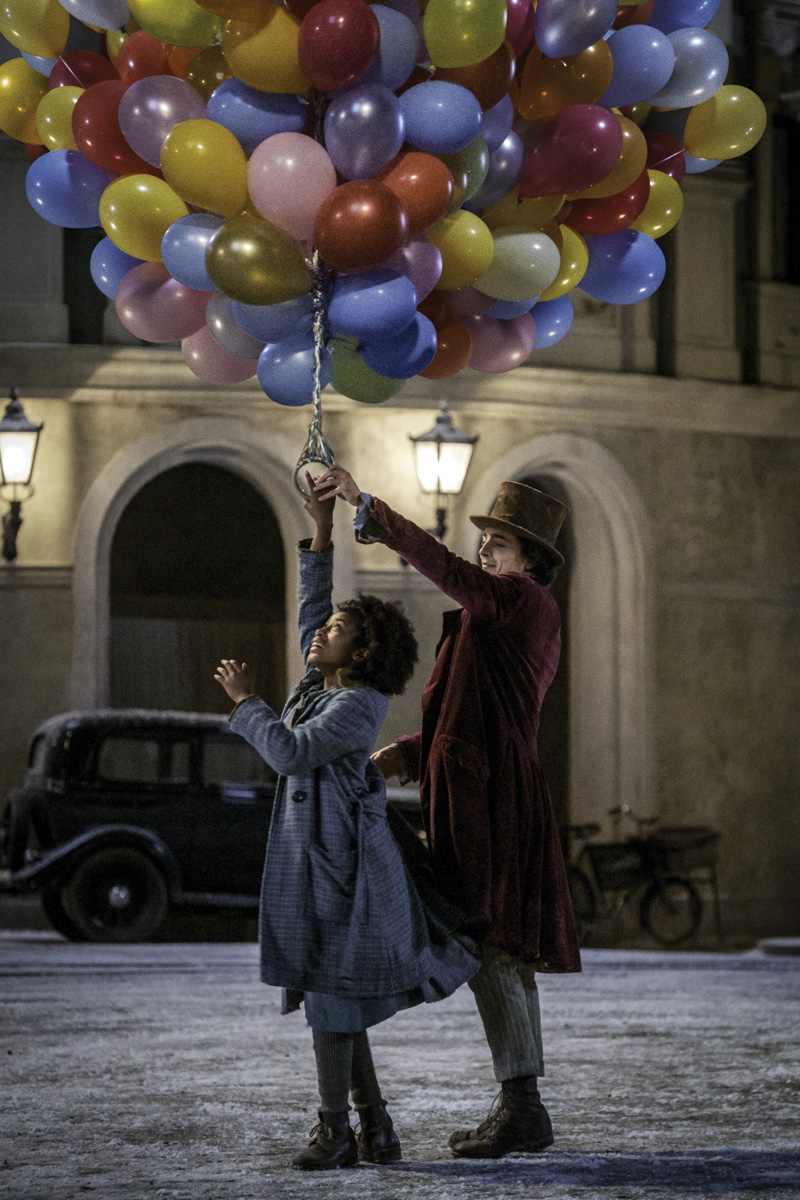
Pure imagination: Wonka
Posted on Jan 11, 2024 by Samara Husbands
Wonka: A World of Pure Imagination
An Oompa Loompa, giraffes and a chocolate waterfall. Will Lawrence talks creating Wonka’s madcap visual effects with Framestore’s Graham Page
St Paul’s Cathedral has held many august events across the last 300 years, from the funeral of Admiral Lord Nelson to the wedding of Charles and Diana.
Sir Christopher Wren’s baroque masterpiece has welcomed heads of state, spiritual leaders – and now a galloping giraffe, a flock of flustered friars and a bumbling, stumbling Rowan Atkinson.
The cathedral’s latest selection of rather eclectic guests comes courtesy of a set piece in Wonka, which alongside Barbie and The Color Purple is one of Warner Bros’ hopefuls for the coming awards season.
Of course, no animals or architectural marvels were harmed in the making of this movie – since the onus for crafting much of the on-screen mayhem at St Paul’s fell upon the visual effects supervisor Graham Page and his team at Framestore.
“To shoot that scene, we had puppeteers and a full-scale puppet of a giraffe,” recalls Page, of the moment the titular chocolatier enters the cathedral atop a giraffe, “and we had to block out the scene we ran through with the monks — so you’ve got all these monks running around and falling over. Then, there is a full-scale giraffe and Rowan Atkinson dressed as a priest. And it’s all happening in St Paul’s – a rather serious place. It was just fantastic.”

Fantastic is an appropriate word for Wonka.
Directed by Paul King (known for Paddington and Paddington 2), the film acts as a prequel to Roald Dahl’s Charlie and the Chocolate Factory, introducing a young Willy Wonka (Timothée Chalamet) who’s bidding to change the world one chocolate at a time.
“It was such a brilliant project because it’s got such a wide breadth,” continues Page. “It’s got the giraffe, flamingos, dogs and Oompa Loompa. There are huge environments and so many fun, quirky details, yet the world has still got to be tangible and real. It’s not swinging so far into fantasy or science fiction that you have free rein. You have to think about how to ground things and make them feel real.”
The script is written by King and his Paddington 2 co-scribe Simon Farnaby (who also stars as the zookeeper), and comes with the blessing of Dahl’s estate.
King is clearly a fan, not only of Charlie and the Chocolate Factory, but also the writer’s whole oeuvre – building his world with elements inspired by Dahl’s broader whimsical canon, like The Giraffe and the Pelly and Me or The Twits.
He also paid close attention to Mel Stuart and Gene Wilder’s iconic 1971 Willy Wonka & the Chocolate Factory, and to Tim Burton and Johnny Depp’s 2005 Charlie and the Chocolate Factory.
“The Gene Wilder film gave us a particular reference for the castle scene at the end of our film,” explains Page. “When we were designing that world, we wanted it to have the feeling of the Pure Imagination scene in the Gene Wilder film. We analysed what they had done, and what came across was the fun and vibrant colour palette.”
One of the most vibrant elements from Dahl’s novel and the two cinematic adaptations are the Oompa Loompas, the small humanoids who help Wonka run his factory.
In the Wilder movie, they were memorably presented as orange-skinned, green-haired men in striped shirts played by actors with dwarfism.
In Wonka, audiences meet just a single Oompa Loompa who is introduced as the hero’s bête noire before their relationship thaws.
Hugh Grant brings the character to life – with more than a little help from the VFX team. Grant says: “Paul King explained how much he loved the Oompa Loompas in those early films, particularly for being so unpleasant. He said, ‘whenever I think of someone really curmudgeonly and unpleasant, I immediately think of you’. And so that was his pitch.”
Creating the character was a difficult process for all involved – including Grant, who referred to the head-mount camera he wore for certain takes as his own ‘crown of thorns’.
For Framestore, the starting point was the design of the Oompa Loompa: “Looking at the silhouette – the costume, the physique, the hair and even little things like the width of his trousers,” Page reveals. “Part of the process was working out what age we felt was right for the character. Paul wanted the Oompa Loompa to be younger than Hugh is in real life; I think we settled on the Bridget Jones 2 era for his age.”
The actor’s face was then scanned, “which involves lots of photographs being taken at the same time from a scanning rig, and then photogrammetry is used to build geometry,” adds Page. “Within that process, Hugh would pull different expressions – and that rough data is rebuilt. Then, it needs a 3D sculptor to tighten it up and add the right details.”
Alongside the digital work, the filmmakers also had to shoot Grant on-set interacting with Chalamet. “The problem there was Hugh is six foot tall, and the scene’s written as a tiny room. We could barely fit the cameraman in the scene and kept on having to pull the ceiling off or pull out the walls.”
Framestore then stitched Grant’s performances together. “It’s incredibly complicated,” according to Page. “You’ve got these different performances and are trying to gel them into one so it feels like a singular one.”
The film features 1163 visual effects shots spread across a host of set pieces and set builds, and Page was particularly pleased with the creation of the factory used at the end of the movie. “We were very involved in that from coming up with lots of ideas going to the castle location,” he says. “We spent a lot of time trying to work out the different parts of the factory.
“There’s the waterfall – and that’s powering these machines, which are pumping the chocolate. Then there’s the area where the ingredients are added and flow through the rainbow bridge, moving on through other contraptions. These then travel into the machine that makes the final chocolate. It was such a fun process.”
This interview was first published in the January 2024 issue of Definition.










